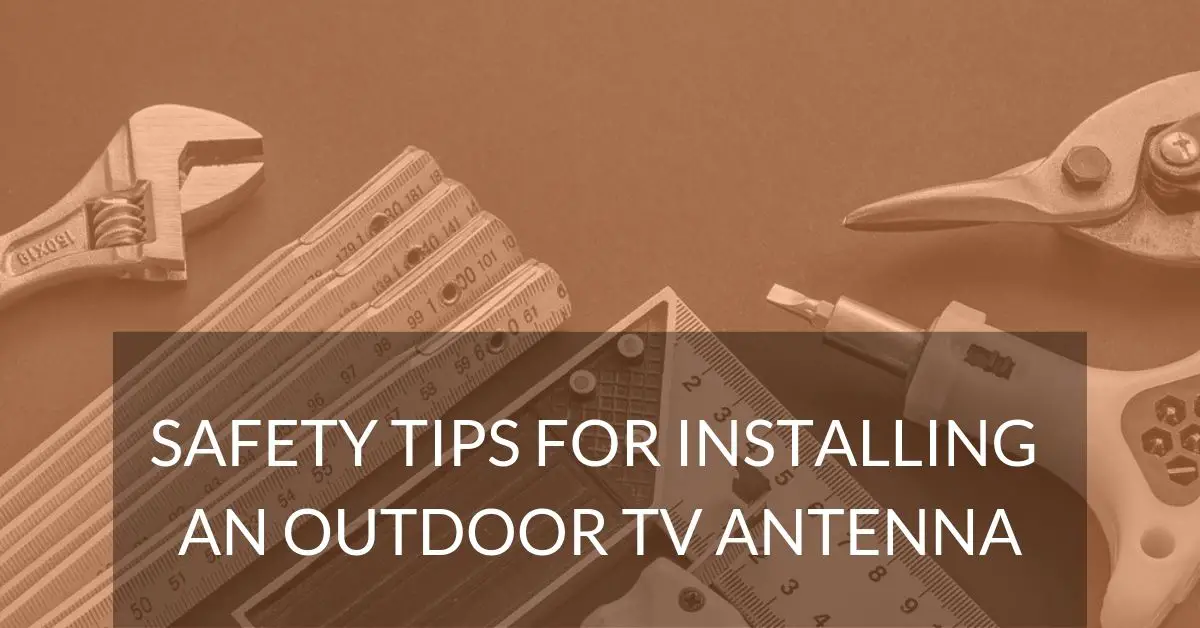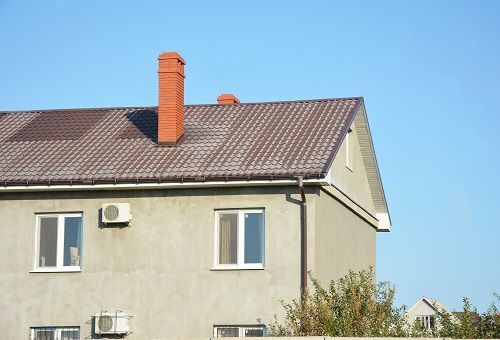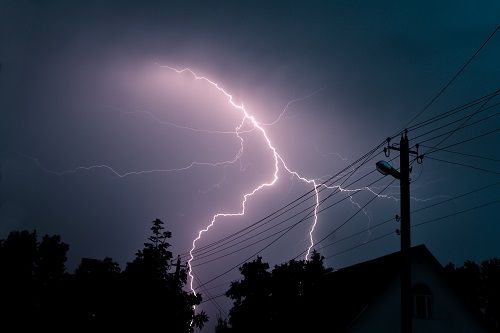
*As an Amazon Associate we may earn from qualifying purchases when you buy through links on our site.
In this article I’m going to summarize some well-known safety recommendations for installing a TV antenna outdoors.
Rooftop work is dangerous and falling is the leading cause of injury among professional roofers, so be mindful of a few guidelines when getting on your ladder.
Some factors to consider:
- How good you are at home DIY
- Height you’ll be working at
- Tools required by the installation
- Ease of access to the installation site
If for any reason you’re unsure about any part of the installation process, then I recommend hiring a professional.
Roof Safety
Of all the places you can install an antenna around your home, your roof is the most fraught with risk. If you’re not a professional roofer, it’s easy to underestimate potential hazards.
According to OSHA, the largest percentage of construction worker fatalities in 2017 was caused by falls from ladders, rooftops, and similar high places.
Taking a closer look at the risks, it’s easy to understand why.
Roofs are high up and offer unstable footing. There’s also the risk of being exposed to the elements – a quick gust of wind or a sudden downpour of rain can have personal consequences.
You may also find yourself working in close proximity to overhead power lines, which can restrict your movement and create tripping or snagging hazards. They also bring the added risk of electrocution.
Further safety implications are caused by the shape and size of the antenna you’re setting up.
The greater the surface area of the antenna, or the longer the mast you’re attaching it to, the more cumbersome the installation process will be.
This is because of the greater likelihood of coming into contact with other objects, such as cables or nearby tree branches while moving and positioning a cumbersome antenna.
Bumping into obstacles could see you losing your balance or grip on equipment.
Shingle roofs present their own set of hazards from missing or damaged shingles, but metal roofs bring things to a new level.
You shouldn’t attempt to get on a slick metal roof that’s wet, and be sure to wear shoes with slip-resistant soles like the Merrell Moab 2 Ventilator.
Lastly, the best thing you can do to keep out of harm’s way and protect property is to make sure you’re prepared before starting the job.

Preparing to Install Your Antenna
You should set aside some time to go through the installation process beforehand, identifying potential hazards.
Read the Instructions for Your Antenna
As with setting up IKEA furniture, reading through the manual first is a great way to visualize the installation process, and may save you a couple of time-consuming trips up and down the ladder.
It’ll also give you an idea of how hard the process will be, and indicate how many hands you’ll need to set things up.
You’ll also want to take special note of any safety advice given by the manufacturer.
Familiarize Yourself with the Installation Site
After you’ve decided where the antenna is going to be installed, think about the best way to access the area.
While you look around for the safest spot to place your ladder, keep in mind:
- The tools and equipment you intend to carry up with you
- The length and width of the ladder
- The angle at which you need to place the ladder — when placed against a wall it should never be at an angle greater than 75 degrees with respect to the ground
- Any available handholds for you to grip while climbing up and down the ladder
Lastly, make sure the area on which you place the foot of the ladder is relatively flat and that it will provide enough resistance to prevent the ladder from slipping.
Installation Area
It goes without saying that the area you’ll be working in should be stable and sturdy enough to support you and those assisting you.
If you’re working on the roof, check for damaged shingles or potential weak spots in advance so you know to avoid them.
Consider also the effects of sudden rains or gusts of wind on your stable footing during the installation.
Power Lines
Note any overhead power lines or wires in close proximity to the site in order to safely navigate them later.
Power lines are generally dangerous; if your antenna comes in contact with them there’s a risk of electrocution.
If for some reason the antenna gets stuck or tangled up in one, don’t retrieve it — call an electrician instead, or the fire department.
Ideally your TV antenna should be installed at a distance of at least double the combined length of the mast and antenna, away from any power lines.
Other Potential Hazards
No two antenna installations are the same, so potential risks can vary considerably from one to the next.
This makes it difficult to list all the potential hazards to look out for, but generally you should also watch out for:
- Overhanging branches: These can interfere with the installation. If possible try to have them cut back before you start.
- Wasp or hornet nests: Check if there are any nearby.

Plan the Installation
By this point you should have a good understanding of all the factors involved in your upcoming installation.
You should also have identified any potential hazards that exist in or around the installation site.
Below are some items to consider:
1. Tools and Equipment
- Get parts and tools ready beforehand, and ensure nothing’s misplaced. If you discover anything that’s not in good condition make sure to replace it before starting.
- Assemble the antenna in advance before hoisting it up to the roof.
- I personally use a toolbelt during installations, which beats going up and down the ladder to retrieve screws. You can use a toolbelt such as the 11 Pocket Leather Tool Pouch.
- Not all ladders are equal. Make sure it’s commercial grade and non conductive, preferably with wide anti-slip rungs to keep your feet firmly in place.
- When positioning your ladder, try to dig the base into the ground to keep it from moving around while you’re on it.
2. Safety Gear
Check your first aid box occasionally to ensure it’s well stocked and keep it somewhere nearby during the installation.
Being pestered by persistent insects while doing tasks requiring two hands can be annoying and even cause you to lose your balance.
Keep a can of insect repellent or wasp spray handy just in case.
Also, grab a pair of durable work gloves but remove them for any work where they’ll be a hindrance.
You’ll also need a pair of good-quality, rubber-soled shoes and clothing that’s not too loose.
3. Discuss and Designate Tasks
When it comes to safely installing TV antennas the cardinal rule is: don’t attempt ambitious outdoor installations alone.
At the very least you’ll want to have someone on the ground whenever you work on the roof or ladder to assist with tasks or to help if something happens.
If you’re mounting your antenna on a mast of 20 feet or higher, you’ll need at least one additional person to assist with the installation.
The best way to keep everyone engaged and cooperating is to assign responsibilities in advance. It’s also important to discuss potential hazards you’ve identified.
4. Check the Weather
Unless you’re installing the antenna in your attic, weather will play an important role in your plans.
Check the weather forecast beforehand: You don’t want to find yourself swinging from the antenna during extremely high winds.
Avoid rainy or snowy weather as well. Working on a wet or icy roof is just asking for trouble.
Checklist of Installation Best Practices
If you’ve followed the safety suggestions till this point, you’ll be familiar with many of the practices below.
- Don’t install your antenna if it’s raining or gusty
- Wear rubber-soled shoes, durable work gloves, a toolbelt, and well-fitting clothes
- Carry a can of insect repellent and wasp or hornet spray with you
- When setting up your commercial-grade, non-conductive ladder, ensure the ground is relatively flat and that it provides sufficient grip for the base of the ladder
- Make sure the ladder, if leaning against a wall, is positioned at an angle to the ground that is no steeper than 75 degrees
- Avoid overhead cables and weak spots on the roof that you’ve identified during your preinstallation survey of the site, and keep clear of any rain gutters as these are notoriously weak
- Don’t attempt to install an antenna that’s to be mounted on a mast that’s taller than 20 feet without requesting additional help
- Ensure the distance between your antenna and any power lines is at least twice the combined length of the antenna and mast
- If you lose your grip on any tool or piece of equipment, such as the mast or antenna, don’t try to catch or grab it as this could cause you to lose your balance. Instead, get out of the way and let it fall
- If any part of the antenna or mast happens to fall onto a power line, DO NOT ATTEMPT TO RETRIEVE IT. Move yourself and others away and contact an electrician or the fire department to assist in the removal
Grounding Your Outdoor TV Antenna
Grounding is a particularly important safety and security aspect when it comes to antennas you install outdoors, as it protects your home and equipment from electrical surges generally caused by storms.
Grounding your outdoor antenna is also a legal requirement in many jurisdictions that have adopted the National Electrical Code (NEC).

Why Grounding is Necessary
During thunderstorms, any outside objects that contain conductive materials and that haven’t been grounded will build up a static electrical charge.
A static charge tends to attract lightning, but lightning can also connect with any conductive objects. Conveniently for lightning, your antenna will be constructed from metal parts and is often at the highest point of the house.
A direct lightning hit to an ungrounded antenna can cause serious damage to your equipment and potentially lead to an electrical fire.
The massive surge of electricity created can travel throughout your home’s wiring, causing havoc and potential danger along the way.
Grounding creates a direct physical connection between an electrical system and the earth, diverting electrical surges into the ground where they can dissipate.
You should ground both the antenna mast and coaxial cable to effectively protect your equipment from power surges, and to be compliant with any local regulations.
Summary
Installing an outdoor TV antenna on your own might seem like an easy way to save some cash, but this isn’t one of those DIY projects where you can afford to cut corners or skimp on tools and equipment.
So, if you’re one of those DIYers who somehow always ends up with an abundance of screws left over after a project, then you might want to sit this one out.
If you decide to go ahead and install it yourself, then keep in mind that many of the inherent risks associated with such a job can be mitigated by the safety tips described above.
Keep your wits about you, work cautiously, and don’t rush things. Oh, and one last bit of advice. Pick your assistant carefully – try to avoid inviting any clumsy friends up onto a roof and arming them with tools and equipment; you have enough potential hazards to worry about.
